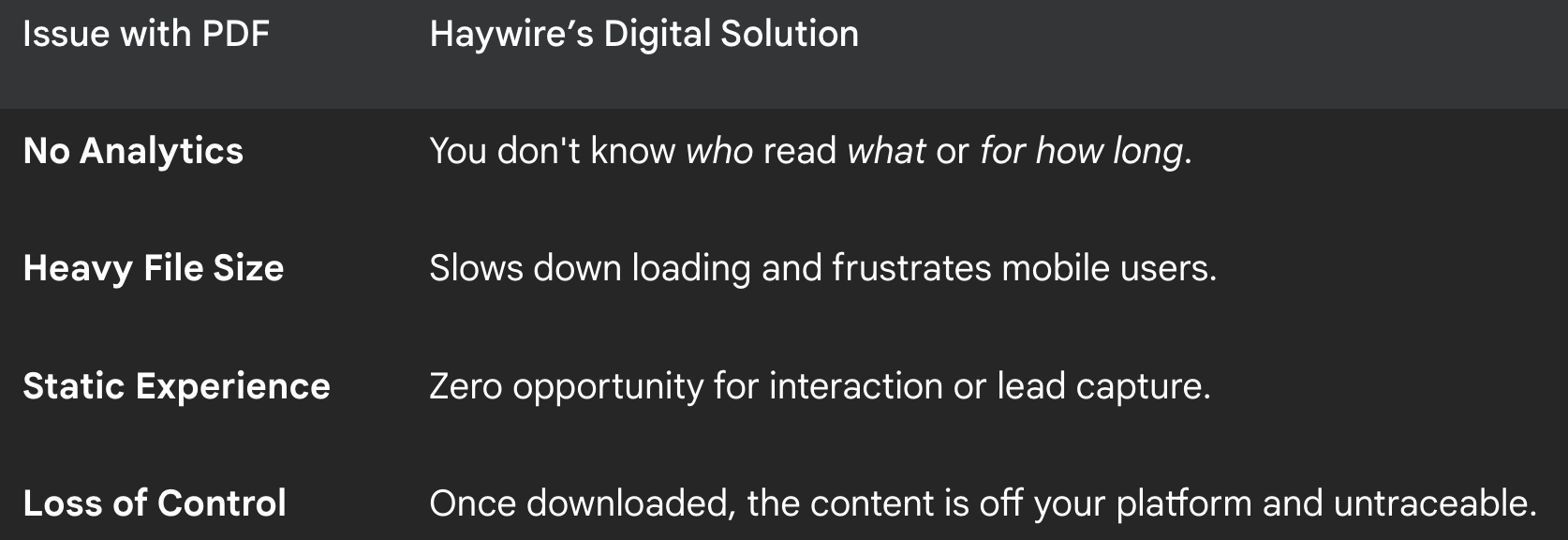From Print to Project: How to Transform Your Lookbook into a B2B Lead Engine
For years, a company’s lookbook was a beautiful, glossy, expensive physical asset—a heavy doorstop of visual branding. It proved your aesthetic, but once presented or emailed, its marketing job was essentially done. This passive approach is no longer a viable strategy for the competitive commercial furniture and architecture/design (A&D) industries.
In the modern digital landscape, that static approach is a liability. Your lookbook is a goldmine of E-E-A-T (Expertise, Authoritativeness, Trustworthiness) and visual content that is currently sitting idle.
At Haywire Consulting, we don't just digitize your assets; we transform them into dynamic, measurable, and potent lead-generation tools. Here is how to make your lookbook work as hard as your sales team and establish your leadership and trust in the highly specialized B2B space.
1. Ditch the PDF: Embrace Interactive Web Format
A PDF download is a conversion endpoint, not a marketing journey. When you rely solely on PDFs, you lose all analytical visibility. The moment a client downloads that file, they vanish from your radar.
The Actionable Shift: Publish the lookbook content directly on your website using a free flipping book software or a dedicated, light-weight landing page. This keeps users on your domain, improving your SEO and allowing for deeper analytics. Control your content; don't just distribute it.
2. Implement Strategic Micro-Conversions for the A&D Community
The goal of the lookbook shouldn't be a generic 'Contact Us' button. It should facilitate micro-conversions related to the specific product or design shown, driving high-intent leads from the A&D community who are actively specifying projects.
Hotspot Links: Every product image should have small, clickable hotspots that lead to specific actions without leaving the lookbook page.
Action 1 (Technical Credibility): Link to a specific CAD file, Revit family, or BIM model download. This is the highest-intent B2B lead you can capture from a designer or architect.
Action 2 (Sales Enablement): Link directly to a "Request a Sample" or "Check Lead Time" form.
Action 3 (Expertise): Link to a related technical blog post (e.g., "The Fire Rating of this Seating System in Multi-Use Environments").
Exit-Intent Pop-Ups: If a user navigates away from the lookbook page, trigger a pop-up offering a high-value piece of gated content, such as "Download the Full 2024 Specification Guide." This trades the content for a verified lead email.
3. Slice and Dice: Atomize Your Visual Content
No one needs to read a 100-page catalog in one sitting. For optimal social media and search performance, you must break the lookbook into its component parts, ensuring your content is seen on every platform.
Reels and TikTok: Use the best short, dynamic video clips from the lookbook photoshoot to create 10-second Reels emphasizing texture, fabrication, or installation before-and-afters.
Carousels: Use the photography to create highly educational Carousel posts on LinkedIn and Instagram (e.g., "5 Ways to Specify Ergonomic Office Seating").
Dedicated Landing Pages: Each major project or product family in the lookbook should be expanded into its own SEO-optimized landing page on your main website. Use the lookbook photo, but surround it with 500+ words of keyword-rich, technical content.
4. Measure the Right Metrics (The Haywire Approach)
The old metric was "Number of lookbooks mailed." The new metric is Conversion Rate by Asset View.
At Haywire Consulting, we focus on which pages, images, and embedded links generate the highest-quality leads. We don't just track views; we track intent.
Metric: Scroll Depth and Time-on-Page for each specific lookbook page. (A designer spending 5 minutes on one page is a serious lead.)
Metric: Micro-Conversion Rate (how many views result in a CAD download or sample request).
Action: If a specific page or product section is converting poorly, we immediately test new CTAs, simplify the copy, or reduce the number of required form fields to maximize conversion success.
5. Beyond Automation: Becoming the Trusted Industry Leader
In a world flooded with AI-generated content, trust is the ultimate B2B currency. Every piece of content you produce must reinforce your brand as the leading, human authority. This is where your digital lookbook strategy elevates you from a generic vendor to an indispensable partner.
The AI Limit: AI can quickly write product descriptions, but it cannot demonstrate the real-world experience of managing a complex, multi-floor furniture installation or the expertise required to advise on local fire codes, building specifications, and material sustainability. Only your firm can provide that human context and guarantee.
The Trust Mandate: By integrating technical downloads (CAD/BIM) directly into your lookbook pages, you signal to architects and designers that you are thinking about their workflow, their deadlines, and their professional needs, not just your immediate sale. This is the foundation of the trust required to secure large, complex projects.
Leading the Conversation: Your goal is to be the resource the A&D community consults before they even look at a competitor. That means your digital assets must be the clearest, most technical, and easiest to use in the industry.
Your lookbook is more than just pretty pictures—it’s an asset that tells a comprehensive story of your expertise. Stop treating it like a brochure and start optimizing it like the lead machine of an industry leader who delivers control and certainty!



